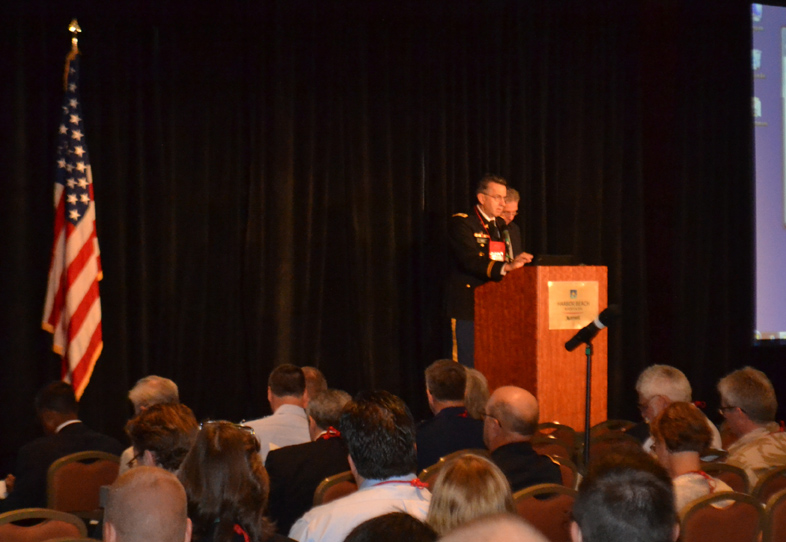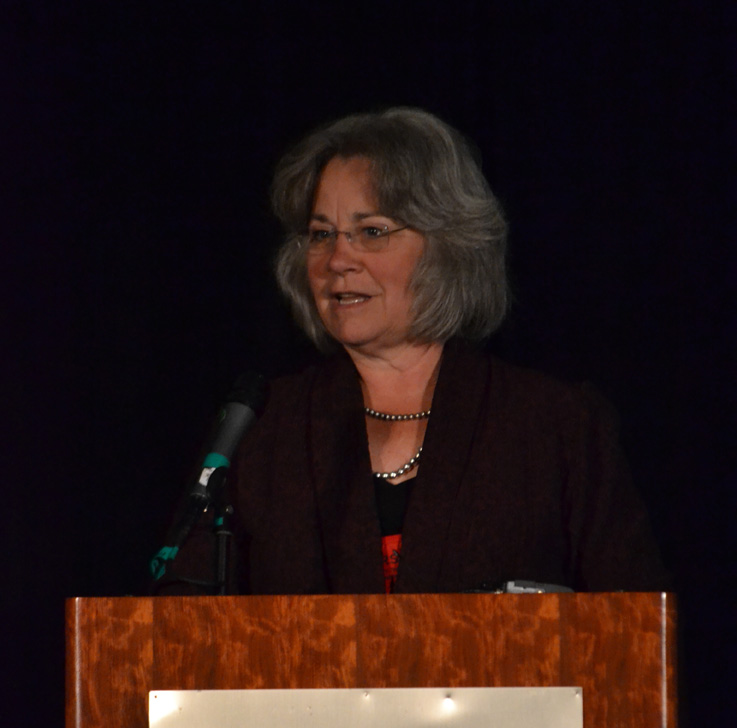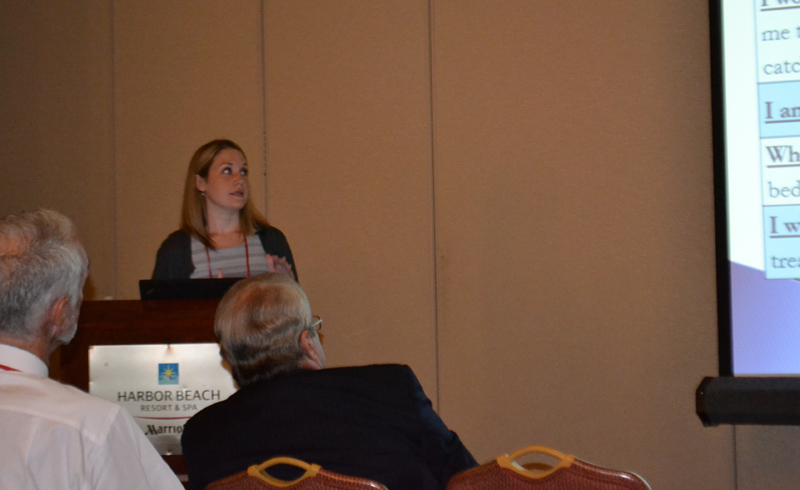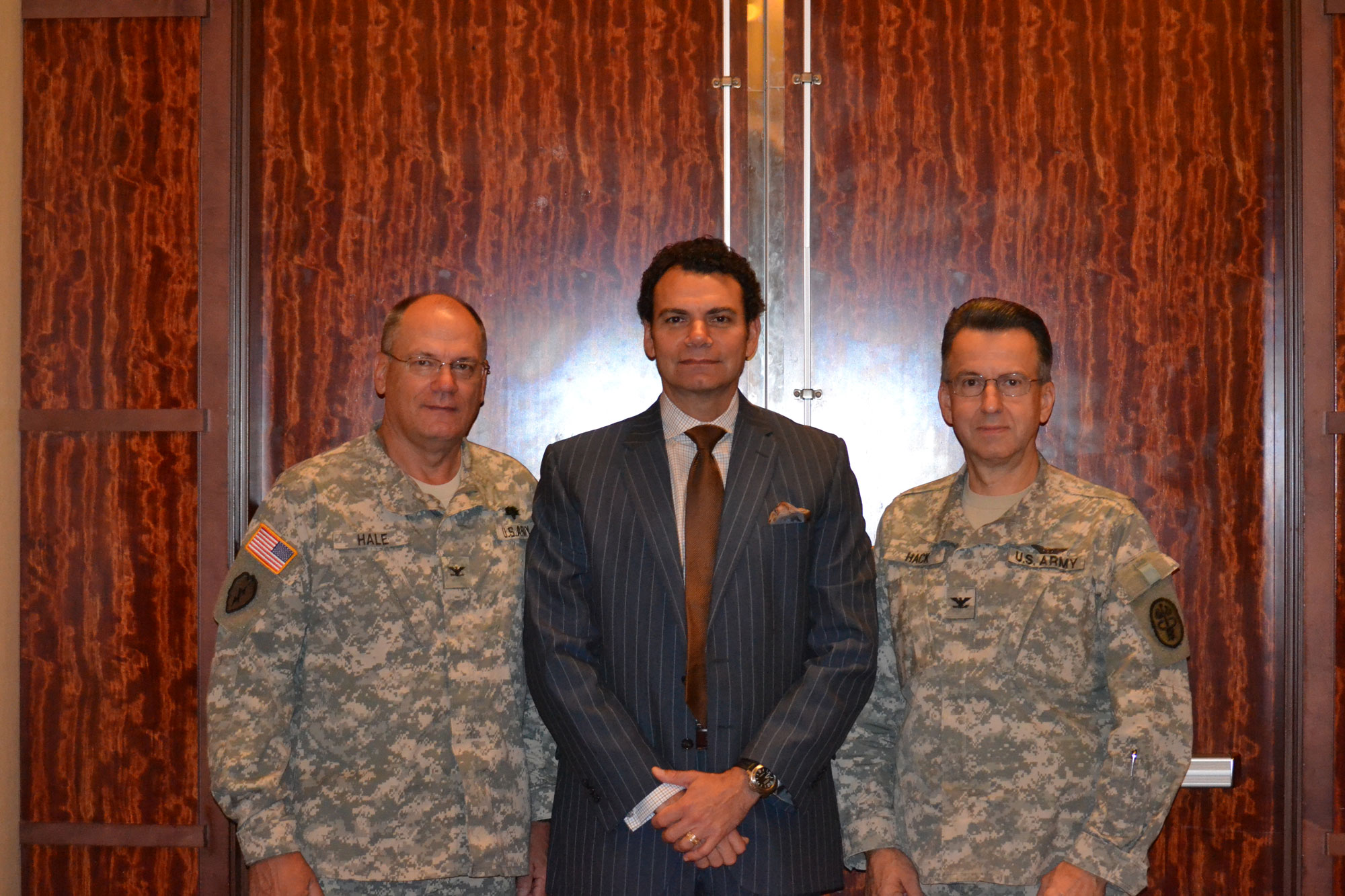MHSRS/ATACCC 2012
News and Events
MHSRS Conference Kicks Off for 2012
 By: Jeffrey Soares, USAMRMC Public AffairsBy: Jeffrey Soares, USAMRMC Public Affairs
By: Jeffrey Soares, USAMRMC Public AffairsBy: Jeffrey Soares, USAMRMC Public Affairs
The 2012 Military Health System Research Symposium welcomed hundreds of participants to Fort Lauderdale, Fla., for its opening day to discuss the latest advancements in healthcare for warfighters Aug. 13. The four-day symposium, sponsored by the Assistant Secretary of Defense for Health Affairs, and organized by the U.S. Army Medical Research and Materiel Command, is a joint effort supported by the U.S. Army, Navy, and Air Force, and brings together scientific leaders and researchers from throughout the world.
"This is the first time that we are combining three previously separate conferences into one joint conference by the Army, Navy, and Air Force," said Col. Dallas Hack, chair of the MHSRS. "We now have a broader range of topics. Before it was primarily trauma care, and now it is this plus infectious disease, operational medicine, medical simulation and training, and force health protection. The interest thus far has been truly amazing."
The vision of the MHSRS is to offer an academic-based forum in which to discuss recent accomplishments and share knowledge regarding military-unique research and development. The annual event provides an opportunity to exchange ideas on planning and developing future studies aimed at optimizing care for members of the Uniformed Services in operational settings, and it has grown rapidly over the past decade.
"This year, we have over 450 presenters, including podium speakers and poster presentations," said Hack, "and we actually had to limit the number of submissions we could accept. We have nearly 1400 people registered, and we probably will see over 1500 when all is said and done. This year's conference is shaping up to be the biggest one yet."
Originally established fifteen years ago as Advanced Technology Applications for Combat Casualty Care, the conference has helped to unify researchers who seek ways to aid the nation's warfighters -- both on and off of the battlefield -- before, during and after deployment. And the research thus far has been very successful.
For example, the general concept of the Armed Forces Institute of Regenerative Medicine grew out of conversations during the 2006 ATACCC meeting, and during the same meeting, the Army and Navy agreed to collaborate on damage control resuscitation, which has greatly speeded up research in this particular area. At the 2001 conference, a discussion between researchers from the University of Florida and Walter Reed Army Institute of Research on the concept of traumatic brain injury, or TBI, biomarkers led to a collaboration to test this hypothesis. This prescient meeting resulted in the first blood test for TBI to enter Phase III clinical trials. In 2008, ATACCC was the site of a joint meeting to discuss Spinal Cord Injury medevac litter efforts, which led to three successful studies regarding the assessment of the effects of vibration, G-force, and shock on casualties during medevac transportation.
"The only reason to have a meeting like this, is to provide 'output' -- to ensure that new things happen in the research field because of all the information shared," said Hack. "Our focus remains the same: to protect, sustain, and treat the warfighter with the most current technology."
Hack said that he has seen an increase in the number of non-DoD personnel attending the conference, such as those from corporations, academia, and clinics, who come to learn more about new advances in the field. Another draw is that Continuing Education Units are offered for many in attendance as well.
"I truly believe the non-DoD personnel are coming to this meeting because they recognize that the DoD is a leader in the field of this type of research," said Hack, "and we've had some major breakthroughs lately."
Because of the increased use of improvised explosive devices during the current conflict overseas, one of the topics gaining much attention recently is TBI, and Hack said this has become a key area of research.
"Over the course of the war, we've had huge progress in the area of massive trauma and massive hemorrhage, and how to treat this," he said. "Now we're starting to see big advances in the area of TBI, and we can look forward to seeing brain injury care translating into larger clinical trials, and into practice within the next year or two. We're looking at the long-term, chronic effects of brain injury, which is very different than past research where we only looked at the short-term effects."
It is important that people understand that the results of this research, originally aimed at the warfighter, eventually makes its way into civilian medical practice, so that millions across the world are able to reap the benefits of these breakthroughs.
And this remains the "silver lining" of the annual MHSRS gathering.
"What continues to amaze me," said Hack, "is the amount of support we get for this conference. So many folks throughout the year write or phone us to say how much they look forward to this meeting, and that it is the best medical meeting of the year."
Obviously, this is a key factor in understanding why the conference has grown over the years, and Hack keeps this at the forefront when planning the event. He said that having the conference in a self-contained facility adds to the impact it has on its attendees. He believes that eating, lodging, and meeting each day in the same location helps to keep people focused on discussing the research presented, which helps to stimulate more ideas and information exchange as the week progresses.
"I'm very excited about what we'll learn this week, and I think everyone will leave with a greater understanding of where we are, and where we can take the field," said Hack.
Back to top
Research Moves Forward as MHSRS 2012 Comes to a Close
 By: Jeffrey Soares, USAMRMC public affairs
By: Jeffrey Soares, USAMRMC public affairs
Closing out another year of medical advancements for the nation's warfighters, the 2012 Military Health System Research Symposium wrapped up its annual conference in Fort Lauderdale, Fla. Aug. 16. There was much enthusiasm throughout the conference hall during the four-day symposium, which is sponsored by the Assistant Secretary of Defense for Health Affairs, and organized by the U.S. Army Medical Research and Materiel Command, in a joint effort supported by the U.S. Army, Navy, and Air Force.
"I think that this conference is important for all of us, and is a unique opportunity to come together across our many disciplines and backgrounds so we may understand each other's needs better," said Dr. Karen Guice, Principal Deputy Assistant Secretary of Defense for Health Affairs.
With each passing year, there has been an increase in the number of non-DoD personnel attending the conference, such as those from corporations, academia, and clinics, who come to learn more about new advances in the field.
"Partnerships across government and with the private sector are the key to long-term success, and these partnerships must deepen in the coming decade," said Guice. "New technologies, new medications, new biomarkers or imaging systems -- they all require partnerships. This entails long-term investments from government, and the sustainment of trusted, evidence-based research and product development throughout the private sector."
The concept of success through partnership held true for this year's meeting as well, as the 2012 conference is the first to combine three previously separate conferences into one joint symposium by the Army, Navy, and Air Force.
"It's the best research conference we've ever had," said Col. Dallas Hack, chair of the MHSRS. "The participation of the U.S. Air Force and Navy, together with the Army, has made it better than I would have ever imagined."
And the tremendous synergy between all of the Services produced a meeting of historical significance.
"We had a record turn-out this year," said Hack. "I'm amazed at the level of support and participation. We had more than 1,500 participants registered."
"Having a large meeting like this," he said, "with all of the collaboration and interaction, saves us from having dozens of other meetings, and it really accelerates the process of pulling together the work that we're doing to provide solutions for our warfighters."
Originally established 15 years ago as Advanced Technology Applications for Combat Casualty Care, this newly structured conference should continue to unify researchers as they seek ways to aid the nation's warfighters before, during and after deployment.
Dealing with medical issues among military personnel that include post-traumatic stress disorder, suicide, traumatic brain injury, and amputation takes a great deal of effort from many individuals on multiple levels. Therefore, a primary goal of the MHSRS each year is to seek effective ways to ensure the physical and psychological well-being of the warfighter.
"Our medical research and development program is an indispensable element of national security," said Guice. "It is important to the men and women we serve, and to all Americans who eventually benefit from the discovery and dissemination of our research."
Although the research is initially pursued from a military perspective, the results eventually reach into the practice of civilian medical providers who utilize the findings to assist millions throughout the world. With nearly 500 conference presenters offering information on recent and future research, it is very likely that much of this information will make its way into standard medical practice in the near future.
Regarding the future of the MHSRS, Hack said, "Soon after the last presentation, we'll be starting to plan next year's meeting!"
Will it be bigger?
"I don't know if it will be bigger," said Hack, "but we're certainly going to work at keeping it as good!"
Back to top
Playing the coping card
 By: Jeffrey Soares, USAMRMC public affairs
By: Jeffrey Soares, USAMRMC public affairs
The protection and treatment of warfighters is a primary focus of the 2012 Military Health System Research Symposium being held in Fort Lauderdale, Fla., and this concern for the men and women in uniform extends far beyond their time on the battlefield. The prevention of suicide among military personnel both during active duty and upon return is of paramount importance for the researchers and attendees of this year's conference.
In a breakout session dealing with advances in military suicide and psychological health research Aug. 15, Dr. Laura Neeley of the Uniformed Services University of the Health Sciences in Bethesda, Md., offered insight regarding her study of Post Admission Cognitive Therapy, or PACT, for the prevention of suicide in military personnel with histories of trauma.
Working with Dr. Marjan Holloway, Neeley's research shows that there is strong empirical support for the relationship between psychological trauma and suicide-related behaviors. However, she states that no evidence-based interventions exist for suicidal individuals with psychological trauma, as suicidal participants are often excluded from psychological research.
This is where PACT may help patients to cope effectively with suicidal thoughts and actions.
"The goal of our research," said Neeley, "is to develop and empirically evaluate a brief inpatient cognitive behavioral treatment for individuals with psychological trauma who have attempted suicide."
Presenting statistics from the current Department of Defense Suicide Event Report, Neeley said that of service members that had attempted suicide, 21.8% had prior psychiatric hospitalizations, and among those service members that died by suicide, at least 10% (and up to nearly 17%) had received inpatient psychiatric care.
"Out of all the various anxiety disorders," said Neeley, "PTSD [post-traumatic stress disorder] has the strongest association with attempting suicide. And combined with alcohol-related problems, it increases the risk of suicide by six-fold."
Considering this, Neeley's research may be quite important, as PTSD is a very active topic currently throughout the military population.
Neeley's PACT program has three phases, with two distinct therapy sessions in each phase. Phase I begins with an analysis of the patient's current suicide attempt, and this leads into a cognitive conceptualization of the events leading up to the attempted suicide. This involves retracing the thoughts of the individual to determine a mood set and behavior. Phase II moves into "cognitive restructuring," to review the negative automatic thoughts of the individual while looking for ways to modify these negative thoughts.
Neeley said that when someone is in a highly emotional state, sometimes it is difficult to generate alternative ways of thinking, so she suggests the use of "coping cards." These cards contain positive statements that provide support to the person who may be in jeopardy of self-destruction.
"Patients can carry these cards in their pocket," said Neeley, "and every time that they have an [event] that leads to an emotional reaction, they can take this out and read it to themselves, to start working on changing their thinking patterns, and working on emotional regulation."
This second phase also includes the implementation of a "Hope Kit," in which patients keep positive reminders inside of a box that they can pull out to remind themselves of the good things in life -- things worth living for. These items can include photos, coping cards, journals, gifts, or other things associated with good memories for the patient.
Finally, the sessions in Phase III are focused on relapse prevention and safety planning.
"In the final stage, we go through the suicide story again, but this time we rewrite it so the patient can incorporate her newly learned skills," said Neeley.
In this stage, the patient must look for ways to challenge thoughts of negativity and suicide, and in doing so, should realize their own self-worth as well as the worthiness of people and things around them.
"We also have them create a 'safety plan' for when they're discharged," Neeley said, "so that they know exactly what to do when they're in crisis."
Created by the patient, this safety plan not only contains certain scenarios of negative actions that the patient should watch for, but more importantly, it contains a list of positive reactions to use in order to squelch negative thoughts, as well as a list of contact persons who may help to calm down and reassure the patient.
Of course, despite Neeley's therapeutic approach to helping change the suicidal thoughts and actions of her patients, the patient's own readiness to change may often provide a roadblock which is difficult to overcome.
In the case of her clinical study patient, Neeley said, "We focused on changing her negative automatic thoughts, which related to a sense of poor self-efficacy, coping with trauma, and other life domains."
Neeley believes the results of this study clearly support the need for evidence-based psychotherapy research for traumatized suicidal individuals. Currently, her group is working on a manualized session-by-session inpatient cognitive behavioral treatment protocol for the treatment of trauma and suicide behavior.
When asked of the patients' response to this PACT treatment program, Neeley said that the reaction to this program has been very positive.
"I've had patients at the end of therapy say that this really helped them, and that the individual attention was very important," said Neeley. "Having this very intensive treatment is very helpful to them, and having it completely tailored to their individual experiences is highly effective."
Back to top
Saving Face
 By: Jeffrey Soares, USAMRMC public affairs
By: Jeffrey Soares, USAMRMC public affairs
At the 2012 Medical Health System Research Symposium in Fort Lauderdale, Fla., high-tech programs and products are being discussed by a multitude of researchers focused on translating futuristic technology into modern-day practice.
In his presentation, Aug. 14, "Comprehensive Facial Transplantation," Rodriquez conveyed how he and his massive surgical team at Maryland used every resource available during a 36-hour surgery to attach a healthy donor face to a 37-year-old gunshot victim whose own face was disfigured. The procedure is considered to be the most extensive operation of its kind ever performed.
And the results are both surprising and remarkable.
Although this particular patient, Richard Lee Norris, was a civilian from rural Virginia, Rodriquez's initial plan was to treat the extreme facial wounds inflicted upon warfighters on the battlefield.
"The ultimate goal of this project was to treat the wounded warrior," said Rodriquez. "We wanted to develop a strategy that would essentially reconstruct the massive disfigurement of the face of these Soldiers [wounded in battle]."
"If you look at our data at the [R. A. Cowley] Shock Trauma Unit, approximately 15% of the patients that come through have some form of facial injury, and in the data from the Journal of Trauma, approximately 30% of all wounded warriors have some form of facial injury," he said. "The ultimate goal is not only to make these patients and Soldiers appear well, but to also ensure that they function normally."
Rodriquez said that many of massive facial injuries have been the result of today's improvised explosive devices, used frequently by rebels in combat scenarios, and from the high energy ballistic injuries that, unfortunately, these Soldiers or patients suffer.
"As injuries between the lower face and upper face are considered very difficult injuries to treat, the operation to repair these injuries must be proportionate to the problem in order to take these patients to the next level," said Rodriquez.
Working within the Shock Trauma Center in Baltimore, Md., Rodriquez and his team -- specialists in craniofacial surgery and microsurgery -- spent hundreds of hours in rigorous training and rehearsal before the patient ever entered the operating room. In a procedure of this magnitude, no margin of error could be tolerated by the surgical team. They studied the underlying relevant clinical anatomy to ensure proper transplantation, and they also considered the procedure from an aesthetic perspective, to see where incisions could be placed in order to go undetected.
The team used computerized surgical planning to ensure the exact transfer of the donor face to the patient, and they were extremely thorough in aligning the oral/dental/tongue configuration during the transfer to ensure that the patient could chew and speak correctly.
Considering the magnitude of this procedure, it is nothing short of amazing that the patient is recovering on schedule at this time. In fact, upon showing a comparison photo of Norris prior to and following the extensive surgery, Rodriquez himself appeared a bit surprised -- and pleased -- about the recovery.
"You can appreciate the dramatic change in this individual's not only appearance but also function," said Rodriquez. "This would not have been possible with conventional measures."
Most would agree that this is an understatement.
The doctor and his team hope to continue with the state-of-the-art craniofacial reconstruction they provide from their facility in Maryland, and Rodriquez looks to maintain, ideally, a goal of 3-5 facial transplantation surgeries per year.
Back to top
Military and Civilian Partnerships for Trauma Care
 By: Jeffrey Soares, USAMRMC public affairs
By: Jeffrey Soares, USAMRMC public affairs
At the 2012 Military Health System Research Symposium, an overriding philosophy is that strong partnerships lead to successful research. No one knows this better than Dr. Thomas Scalea, physician-in-chief of the University of Maryland Shock Trauma Center, Baltimore, Md., whose group has teamed with the U.S. military to advance the study and treatment of severe injuries in both the military and civilian sectors.
Scalea said that the military-civilian partnership over the years has yielded a tremendous amount of "cross pollination" of clinical care, in mostly trauma and critical care scenarios. What was born out of necessity on the battlefield has grown into a vital operation in saving lives daily, from bustling city streets to quiet neighborhoods, to ensure that severely wounded patients are treated as quickly as possible.
"Evacuation of casualties -- helicopter transport -- that was born in Korea and Vietnam has really morphed into the civilian sector in a big way," said Scalea, "and we are now involved in a very large discussion on who ought to be transported by ground and who should get flown -- but all of that really started in the military."
Today, Scalea's team at Maryland's Shock Trauma Center use medical concepts that originated in combat casualty care, and his tour of U.S. military operations overseas in Afghanistan has helped to shape his vision.
"The whole concept of Damage Control Resuscitation was started on the battlefield," said Scalea, "and all of that [research] has gone from the battlefield into civilian practice."
The military's system of Critical Care Air Transport, which involves transporting battlefield victims to military hospitals, has helped to define the current practice of "life-flighting" civilian patients with serious wounds to hospitals via helicopter directly from the accident scene.
Of this method Scalea said, "I really got the idea for this when I was in Afghanistan. I said, 'We can do this, but we just need to use it in a different way.'"
Tourniquets, shunts, local haemostatic dressings, and various other medical items are going from the battlefield, sometimes directly, into civilian practice. Military doctors with their invaluable experience are coming out of the Services and bringing their knowledge into the civilian sectors.
The partnership between military and civilian medical practitioners over the years has led to many breakthroughs in life-saving procedures, and the basis for this concept of early intervention was championed decades ago by the man who would eventually create Maryland's Shock Trauma Center, R. Adams Cowley.
In praising Cowley, Scalea said, "It was R.A. Cowley who came back from [the war in] Korea with the concept that injury was a 'time-sensitive' disease, and he then coined the term 'The Golden Hour.' Cowley believed that there is a 'golden hour' between life and death, and if you're critically injured, you have less than 60 minutes to live. In his mind, he already had the concept of irreversible shock."
As modern-day medicine evolves along with the strengthening of military-civilian partnerships in the field, Scalea said that two strong examples of real innovation in this partnering are comprehensive facial transplantation and reviewing genetic profiles to drive care and treatment. Both of these avenues have seen great successes recently, and he remains confident that more success stories of this unique collaboration will be seen in the not-too-distant future.
Back to top